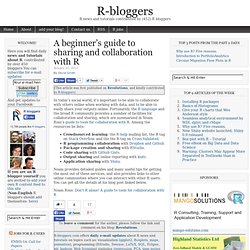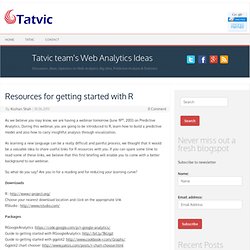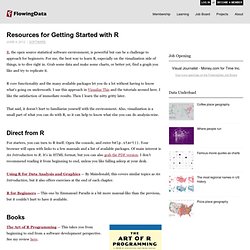

A beginner’s guide to sharing and collaboration with R. In today's social world, it's important to be able to collaborate with others online when working with data, and to be able to easily share your outputs online.

Fortunately, the R language and the broad R community provides a number of facilities for collaboration and sharing, which are summarized in Noam Ross's guide to tools for collaboration with R. Among the resources he lists: Crowdsourced learning: the R-help mailing list, the R tag on Stack Overflow, and the the R tag on Cross-Validated.R programming collaboration with Dropbox and Github.Package creation and sharing with RStudio.Code sharing with Github Gists.Output sharing and online reporting with knitr.Application sharing with Shiny. Noam provides detailed guides and many useful tips for getting the most out of these services, and also provides links to other online communities where you can interact with other R users. You can get all the details at his blog post linked below. Picking a gui interface for R. Recently I decided to switch statistical programs used introductory statistics course for masters students that I teach at the University of Arkansas.

Historically this course has been taught with SPSS, but I am attempting the switch to R this semester. Most students in this class have never used a statistical program before and have no programming background/interest. Introduction to R, a video series by Google. Resources for getting started with R. As we believe you may know, we are having a webinar tomorrow (June 19th, 2013) on Predictive Analytics.

During this webinar, you are going to be introduced to R, learn how to build a predictive model and also how to carry insightful analysis through visualization. As learning a new language can be a really difficult and painful process, we thought that it would be a valuable idea to share useful links for R resources with you. If you can spare some time to read some of these links, we believe that this first briefing will enable you to come with a better background to our webinar. So, what do you say? Are you in for a reading and for reducing your learning curve?
Top 10 tips to get started with R. 10 R packages I wish I knew about earlier. I started using R about 3 years ago.

It was slow going at first. R had tricky and less intuitive syntax than languages I was used to, and it took a while to get accustomed to the nuances. It wasn't immediately clear to me that the power of the language was bound up with the community and the diverse packages available. R can be more prickly and obscure than other languages like Python or Java. Learn about R through data mining. If you're in San Francisco for this week's DeveloperWeek conference, our own Joe Rickert will also giving a presentation on Wednesday at 2:10PM on Predictive Modeling with Big Data in R which will feature several demos of data mining massive data sets using the Revolution R Enterprise.

Incidentally, the whole team Revolution Analytics was proud to receive the Top Innovator award for Big Data Technologies from DeveloperWeek. Getting staRted with R. As a PhD student and researcher, I often hear friends and colleagues say that they want to learn R, but that the learning curve is so steep that they can't seem to get started.

It's true that learning any tool as powerful as R can be confusing at first, especially if you are not accustomed to typing commands in a terminal. That said, there are TONS of resources available for learning R. This post describes some of the resources that I have found most useful in my jouRney. Don't R alone! A guide to tools for collaboration with R. This a brief guide to using R in collaborative, social ways.

R is a powerful open-source programming language for data analysis, statistics, and visualization, but much of its power derives from a large, engaged community of users. This is an introduction to tools for engaging the community to improve your R code and collaborate with others. (Am I missing anything? Let me know in the comments and I’ll update this guide.) R-Uni (A List of Free R Tutorials and Resources in Universities webpages) Review of “R For Dummies” The authors are Andrie de Vries and Joris Meys.

Executive summary Pretty much all I’d hoped for — and I had high hopes. Significance The “Dummies” series is popular for introducing specific topics in an inviting way. R For Dummies is a worthy addition to the pack. There is a competitor by the name of Statistical Analysis with Excel For Dummies. There are millions of people doing data analysis in spreadsheets, even though spreadsheets are dangerous. Annotations for “R For Dummies” Here are detailed comments on the book.

Elsewhere there is a review of the book. Resources for Getting Started with R. R, the open source statistical software environment, is powerful but can be a challenge to approach for beginners.

For me, the best way to learn R, especially on the visualization side of things, is to dive right in. Grab some data and make some charts, or better yet, find a graph you like and try to replicate it. R core functionality and the many available packages let you do a lot without having to know what's going on underneath. I use this approach in Visualize This and the tutorials around here. I like the satisfaction of immediate results. That said, it doesn't hurt to familiarize yourself with the environment. Video: Getting staRted with R: An accelerated primer by Lyndon Walker – Melbourne R Users.
Computing for Data Analysis. UseR! 2011 slides are now available. Online Course from Statistics.com: Advanced Programming in R. Hadley Wickham teaches “Programming in R – Advanced,” June 15 – July 13 online at Statistics.com. This is the third in a series of courses that cover programming in R, so if you are new to the subject you should start with our Jul 27 course “Introduction to R: Data Handling.” Jun 15: Advanced Programming in R (more below) 20: Visualization in R with GGplot2 27: Introduction to R – Data Handling 27: Introduction to R – Statistical Analysis 31: R Modeling 19: Graphics in R 26: Programming in R In “Programming in R Advanced,” you will hone your skills to work with a variety of data types and data sources in R.
You’ll also learn some techniques for programming “in-the-large,” when you are trying to provide a suite of functions to flexibly solve a large class of problems. In particular, you’ll learn more about functions, environments and closures, and the basics of object oriented programming with S3. Dr. Simplifying Loops in R. One of the things I do frequently in my research is the apply some function on a large number of rows in a data set.
I am a great fan of the loop structure in R, and use this a lot. I know one should always vectorize and avoid loops in R, however for me it is easier to write my code using loops as it mirrors the way I think about a given data problem. This has the unfortunate consequence that sometimes my R scripts become unwieldy and take hours to run. Reading The Art of R Programming I recently came across a simple way to avoid large loop structures, by feeding functions to the apply() function. I have read about this before but the explanation of it in the above mentioned book opened my eyes. R starter resources. I’m hardly the first person you would want to talk to about learning statistics in R.
But if you’re bent on teaching yourself R, and you’ve ended up at my blog, here are some resources I found useful. (No opinions here about whether R is good/bad better/worse than Excel, Minitab, Matlab, Octave, SPSS, Stata, SAS, or others.) R Rroject is the mothership. 2 min HOWTO in R. R-TreeBASE Tutorial. My treebase package is now up on the CRAN repository. (Source code is up, the binaries should appear soon). Here’s a few introductory examples to illustrate some of the functionality of the package. Thanks in part to new data deposition requirements at journals such as Evolution, Am Nat, and Sys Bio, and data management plan requirements from NSF, I hope the package will become increasingly useful for teaching by replicating results and for meta-analyses that can be automatically updated as the repository grows.
Please contact me with any bugs or requests (or post in the issue tracker). Basic tree and metadata queries Downloading trees by different queries: by author, taxa, & study. We can query the metadata record directly. (This query could also take a date range). How do the weekly’s do on submissions to Treebase? Now get me all of those treebase trees that have appeared in Nature. R twotorials: sixty two-minute r twotorials now available. An intro to R. Learning R as a language. Books written to teach a general purpose programming language are usually organized according to the features of the language and examples often show how a particular language feature is interpreted by a compiler. Books about domain specific languages are usually organized in a way that makes sense in the corresponding application domain and examples usually illustrate how a particular domain problem can be solved using the language. I have spent a lot of time using R over the last year and by dint of reading lots of R code and various introductions to the language I have managed to piece together a model of the language.
I managed to one introduction to R written from the perspective of the programming language (and not the application domain): the original The Art of R Programming by Norman Matloff has been expanded and is now available as a book. Summary. R Links for the Beginner on World Statistics Day. Wednesday, October 20, 2010. If you have to use circles… Stats Chat is an interesting kiwi site—managed by the Department of Statistics of the University of Auckland—that centers around the use and presentation of statistics in the media.
This week there was an interesting discussion on one of those infographics that make you cringe: I understand the newspaper’s need to grab our attention, as well as the designer’s esthetical considerations, but they have to follow avoiding misleading the reader and providing at least a ball-park idea of the importance of whatever issue is under discussion. Clearly, as pointed out in the discussion, a line chart would convey the message with a minimum of ink; however, the designer may still want to use circles, and here we could go back to a faceted version of the always maligned pie chart. Faceted pie charts using ggplot2 The code reads the data, reshapes it and plots it using pretty much the explanation for pie charts in the ggplot2 documentation.
How to create the best Interactive R Language Online Learning Platform from the views of R community? (This article was first published on PR, and kindly contributed to R-bloggers) The art of R programming. R is a language. Physical books of “The R Inferno” and “S Poetry” Book shoppin’… The Art of R Programming – my two cents. What makes this book different from other books about R is stated clearly by the author Norman Matloff in the introduction: The R Journal.
Permanently Setting the CRAN repository. Setting the CRAN repository so that it does not ask every time you try to install a package is something that I think few people bother to do, but it is so simple and can save a fair bit of frustration when working. This is accomplished through a setting in one of the Rprofile files.
There is the site file found at either. Install RMySQL on Win7. Global Volcanic Eruptions. R Cheat Sheets. Week in Review 021211 R Language. Happy last month of 2011. I will fly to Sydney to present a paper at the 24th Australasian Finance & Banking Conference on next Thursday, so we may not have a review next week. However, feel free to contact me @a_biao for sharing any useful post. Robin Beaumont. Teaching with R: the tools. R Tutorials from Universities Around the World. Home Page. R Cookbook with examples.